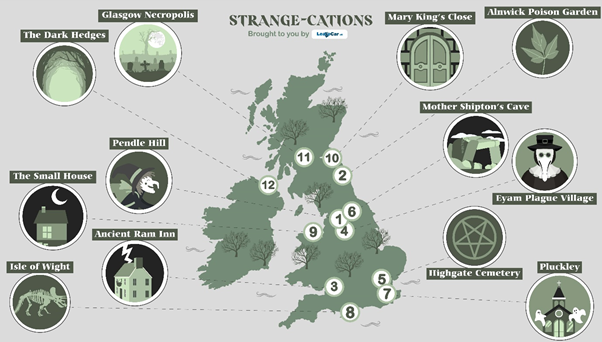Families looking to take a more unusual trip in the UK once it’s safe to travel have been offered 12 suggestions of weird and wonderful places to visit.
The LeaseCar.uk team have researched and revealed a variety of spooky and kooky sites in England, Scotland, Wales and Northern Ireland, for travellers seeking unique trips and days out.

Visitors to Northumberland have been urged to pay a visit to Alnwick Poison Garden, an attraction that’s home to 100 species of toxic and narcotic plants.
And in Lancashire, travellers should prioritise a trip to Pendle Hill, a site that is shrouded in mystery and stories of witchcraft.
Other locations to visit and strange attractions include haunted inns, plague villages, quirky caves and prehistoric dinosaur sites.
A spokesperson for LeaseCar.uk said: “With its ancient – and often bloodthirsty – history, the UK boasts more than its fair share of weird, spooky and kooky sites.
“From poisonous plants and petrifying wells to plague villages and impressive necropolises, there’s plenty of things to see, do and learn in the UK that are a little out of the ordinary.”
Pendle Hill, Lancashire
Most famous for its links to the now notorious witch trials of 1612, Pendle Hill and its surrounding towns and villages are a truly bewitching part of Lancashire. Ten alleged witches were buried beneath the hill, having been hanged at Lancaster Castle. Pendle Hill looms over this ancient hunting ground – once the home of wolves and wild boar. The landscape welcomes walkers and countryside enthusiasts, with plenty of country inns and farmhouses to provide rest and refreshment along the way.
Alnwick Poison Garden, Northumberland
Stunning to the eye but deadly to the touch, each of the plants inhabiting Alnwick Poison Garden are – you guessed it – poisonous. Visitors are strongly forbidden from touching, smelling or tasting any of its 100 toxic and narcotic species. Run by the Duchess of Northumberland, Jane Percy, this garden rests behind large black iron gates and is the perfect unusual day out in England.
Ancient Ram Inn, Gloucestershire
The Ancient Ram Inn, built way back in the 12th century, is one of the most supposedly haunted sites in the UK. It was apparently built on an ancient pagan burial ground, and is now the UK epicentre of the ghost hunting world. It’s no longer a pub but the Ancient Ram Inn still hosts events, paranormal investigations, and “open days”.
Eyam Plague Village, Derbyshire
During the bubonic plague outbreak of 1665-1666, the inhabitants of Eyam quarantined themselves, in a famous act of self-sacrifice, to prevent the spread of the plague. Despite its morbid history, the village makes for a fascinating day out in the Peak District. The museum is a great place to begin your visit.
Highgate Cemetery, London
Opened in 1839, over 170,000 people have since been buried in Highgate Cemetery, including author of the Communist Manifesto Karl Marx, novelist George Eliot, rock star Gene Simmons, and writer Douglas Adams. Rumours of occult meetings, Satanists and witches gathering in the cemetery have persisted for years. Admission is by timed ticket which you can purchase online.
Mother Shipton’s Cave, North Yorkshire
One of England’s oldest visitor attractions, this cave is where the famous Yorkshire prophetess Mother Shipton is said to have been born. It’s right by the ‘Petrifying Well’, a unique geological phenomenon which never fails to impress visitors, as its water appear to turn objects to stone! The park that is home to Mother Shipton’s Cave and the Petrifying Well is a unique, unspoilt remnant of the Royal Forest of Knaresborough.
Pluckley, Kent
A picturesque village in Kent, Pluckley was named Britain’s ‘most haunted village’ in the Guinness Book of Records in 1989, thanks to the twelve ‘official’ apparitions that roam the place. Just a short drive away from London, there are a number of spots around the village that have a distinct “feel” to them. Several of these haunted places are connected to the Dering family, Lords of the Manor from the 15th century up until World War I.
Isle of Wight
If you and your family have a penchant for prehistoric treasures, head to the Isle of Wight – dubbed the UK’s dinosaur capital by National Geographic. The majority of the island’s dinosaur treasures can be found along the southwest coast, with footprints and casts to be seen at Hanover Point, Compton Chine, Sudmoor Point, Chilton Chine and Cowleaze Chine. Fossils dating from the Lower Cretaceous period are littered along this stretch, but for abundance, set your sights on Compton Bay.
The Small House, Conwy
The smallest house in Great Britain can be found nestled amongst a terrace of houses on Conwy’s quayside. It was occupied right up until May 1900, and ever since it had been visited and marvelled at by thousands of people from around the world.
Mary King’s Close, Edinburgh
Beneath the hustle and bustle of Edinburgh is Mary King’s Close, a 17th century street that has become a popular tourist site. Once home to hundreds of inhabitants, Mary King’s Close was emptied and sealed up at the beginning of the 20th century. It was later rediscovered by workmen who were digging on the street above and accidentally punched down into the winding streets.
Glasgow Necropolis, Glasgow
This mega-cemetery stands adjacent to Glasgow Cathedral and was created following increased demand for more cemeteries in Britain in the 19th-century, after the creation of Père Lachaise Cemetery in Paris. There are around 50,000 people buried in the Necropolis, but only a small percentage have gravestones – and even fewer have names. Approximately 3,500 monuments exist here.
The Dark Hedges, Ballymoney
The Dark Hedges is an avenue of beech trees in County Antrim, Northern Ireland. The trees were planted by the Stuart family in the eighteenth century, and now they form an ethereal tunnel that has become one of Northern Ireland’s most photographed destinations. Game of Thrones fans will recognise it as the King’s Road from the hit TV show.
